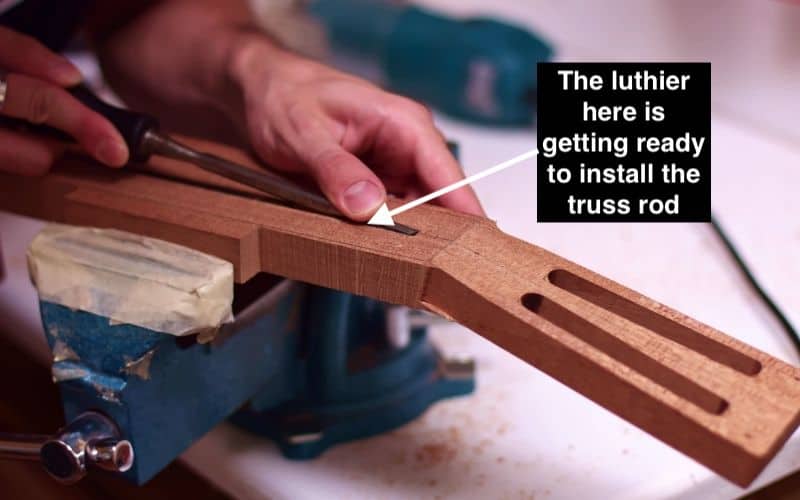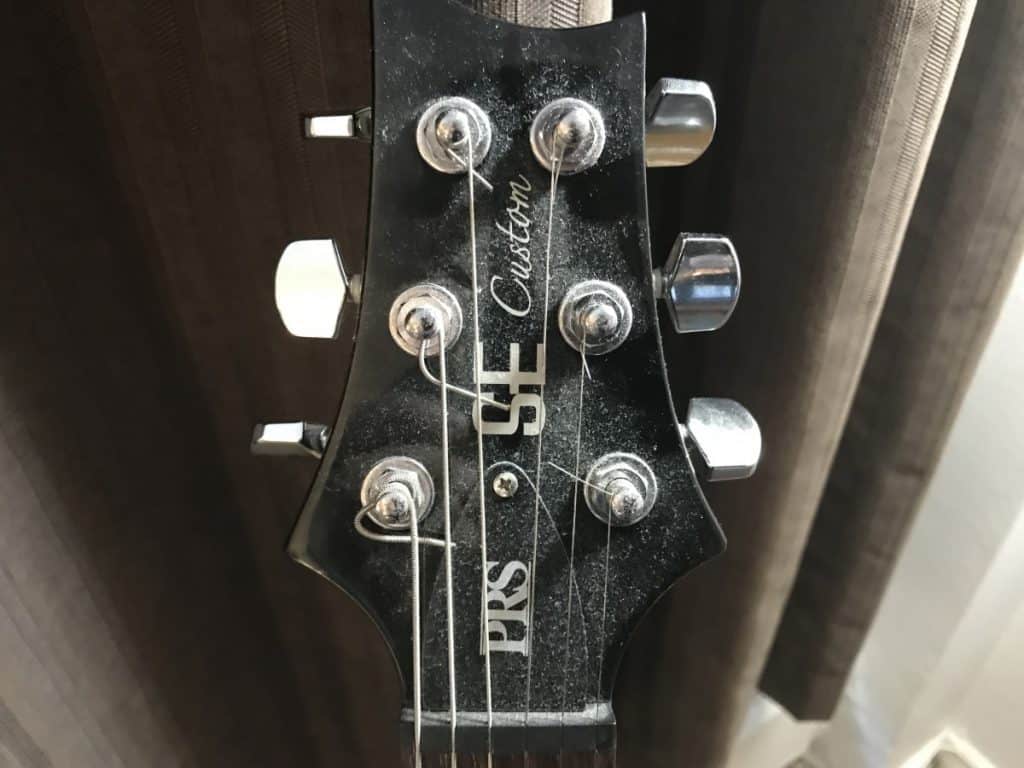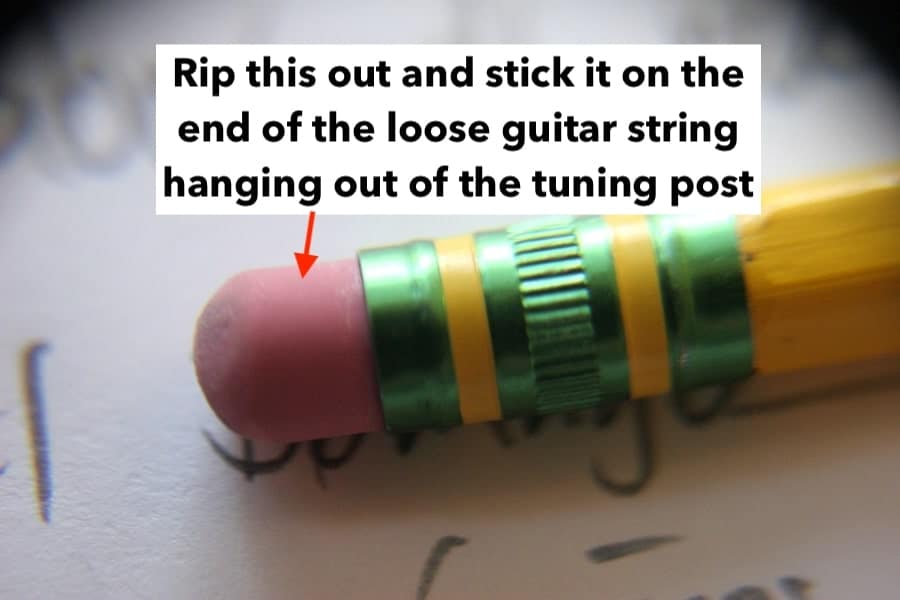During the creation of this blog alongside my other one, Producer Society, I’ve found myself surprised by some of the questions that people ask about guitar playing and music production, notably, questions surrounding the purported danger of them.
For instance, a lot of people wonder if guitar strings are dangerous, which is something I never really thought about. Sure, I’ve snapped many strings in my life and worried for a second that maybe it was going to hit me in the face, but other people have taken that to the next level.
Guitar strings are not dangerous, although, you can prick your fingers on them and they commonly snap when they’re worn out or if they have been bent with too much pressure. However, when they do snap, they usually don’t fling out due to a lack of elasticity so your should be safe.
Explained in another way, sure, guitar strings could be dangerous if you want to think of all the possible unlikely permutations of reality, but I would say they’re not really dangerous unless you wanted to use them as a weapon of strangulation like a garrote.
I’ve played guitar for over 15 years now, and the most danger I’ve ever found myself in was pricking my fingers on the end of a string when they’ve been cut off at the headstock’s tuning peg.
Occasionally, I’ve lost my balance a few times while carrying my amplifier to my drummer’s house, but other than that, the opportunities for danger have been scarce.
The Main Reason Why Guitar Strings Aren’t Dangerous
1) Guitar Strings Don’t Fling Out Due to a Lack of Elasticity

It’s probably rather intuitive of a person to worry about the dangerousness of guitar strings due to being wound so tight on the instrument. As most players know, strings are wound so tight on stringed instruments that they pull on the neck.
Most stringed instruments have a metal rod inside of the neck which gives it a certain amount of relief or tension.

It’s called the truss rod, and it can be adjusted in a number of ways depending on the specific model. The guitar neck’s truss rod responds to stress and tension created by the strings which are pulled tight so they’re able to produce vibrations.
However, the guitar strings – which are made of a steel core-wire and wrapped in nickel-plated steel or phosphor bronze – don’t have that much elasticity. This means when the strings finally snap, they don’t fling out like the way an elastic band would.
For example, when I was a kid, my friends and I would snap elastic bands at each other and literally sling-shot them across the room during class, on the bus to school, and even at home too.
Thankfully, guitar strings don’t have the same amount of elasticity, so you can’t fling them at people in the same way. With that said, I’m sure there are the rare cases where someone has gotten hurt somehow, but most people shouldn’t have to worry.
Where Guitar Strings Can Be Harmful
1) When Hanging Out Of the Tuning Peg
A few times in my life, particularly when I first started playing the guitar, I did prick my fingers on the ends of the strings by accident.
After you’ve strung the strings around the tuning peg, if you aren’t careful, the string-ends can be very prickly and sharp, so be careful not to touch them with your fingers. You can see what messy strings look like in the image below.

One way of getting around this however is to just tuck the strings underneath the tightened strings like what you can see on my beloved PRS SE Custom 24 down below.
This should be more than enough to ensure that the ends of the guitar strings aren’t particularly dangerous to you or anyone else.
Although, even if you didn’t tuck your strings like this, they wouldn’t be that big of a deal, unless you went around swinging your guitar at people like it’s an axe.

Another thing that people do – that I’ve actually discussed before but don’t really recommend – is putting little pieces of erasers on the end of the guitar strings so as to prevent them from pricking anyone.
Personally, I think this is a bit overkill and unnecessary, but maybe you have a young child walking around and their eye level is close to the headstock. At the end of the day, it’s really not hard to just cut the strings off with a pair of pliers.

2) While Changing Them

I would argue that if changing your guitar strings is dangerous, it would probably be while you’re changing them which you should do fairly frequently as I pointed out in my guide.
Whenever I change my strings – I usually use light-top/heavy-bottoms from Ernie Ball – I generally move with a bit of caution, but not ridiculously so.
This has to do with my first point, which is that they could pose a danger but in 99.99% of cases it’s not something you have to worry about it unless you’re doing something weird or wild. If you’re careful when you’re stringing them and understanding that the ends are a bit sharp, you should be ok.
3) If You Eat or Lick Them

This one is obvious, but the other main way that guitar strings can be hazardous is if you put them in your mouth, eat them, or maybe leave little pieces of steel strings on the floor.
In other words, after you’ve strung your guitar strings up on the headstock, make sure that after you’ve cut them off, you haven’t left the little pieces of steel on the carpet or on the floor, because someone could step on them.
This is a surprisingly big one. Don’t forget to clean up your mess, because they will prick your feet.
Another point of contention surrounding guitar strings has to do with the idea that they could snap on their own if you had your face over the headstock at some point.
Personally, I believe this is another one of those freak accidents that’s probably not worth thinking about.
In fact, I’ve already written an article on the subject, but the most important from it is that while guitar strings could break on their own, it’s not something that should take up any mental space.
What About Toxicity Due to Heavy Metals? Are Guitar Strings Health Hazards Due to Poisonous Chemicals?

Guitar strings are not hazardous because the amount of heavy metals used to make them doesn’t pose enough of a threat to cause any harm. The purported toxicity of the heavy metals that are used to make guitar strings is another cause of concern for some people.
This is another one of those things where guitar strings could be potentially hazardous, particularly if you’re allergic to nickel, chromium, brass, or bronze, but for most people, this won’t be a concern at all.
With that said, there are some people who will have allergic reactions to things like nickel, and there are cases where instrumentalists and musicians come into contact with their instrument so often that they actually do have reactions to the metals
. I have a whole other article about the purported toxicity of strings, so I recommend checking that out for more information, which includes official studies and data.
Important Things to Note About the Supposed ‘Danger’ of Guitar Strings

1) You Might Prick Your Finger But You Should Be Ok
Other than the danger of pricking your fingers on the end of the guitar strings, you should be ok in 99.9% of the cases. I’ve pricked my fingers on guitar strings a few times in my life, but usually, the damage done isn’t that bad, and it’s almost always completely avoidable with a bit of mindfulness and caution.
The only other way I’ve actually caused harm to myself via guitar strings had to do with taking a long period of time off away from the instrument.
Let me explain: if you don’t play guitar for 6-8 months (which is enough time for your finger calluses to completely go away), and then you hop back on the guitar as if you never missed a day, you could rip the ends of your fingers open.
This is especially pronounced if you use heavier gauge strings as I do. Just be mindful of bending and how hard you fret if you haven’t played the guitar for several months and are looking to get back into it.

 Written By :
Written By :